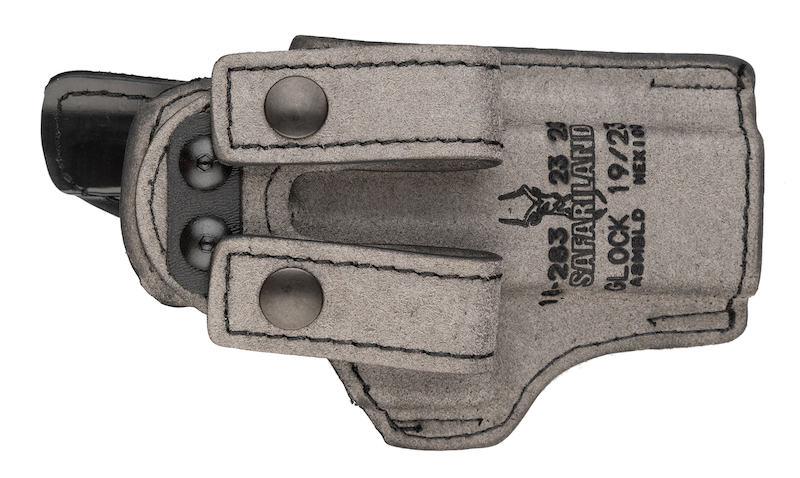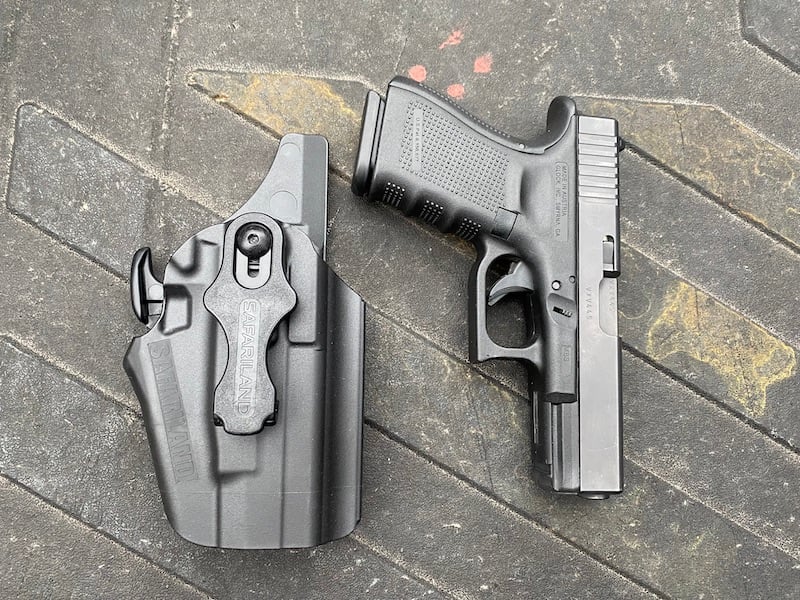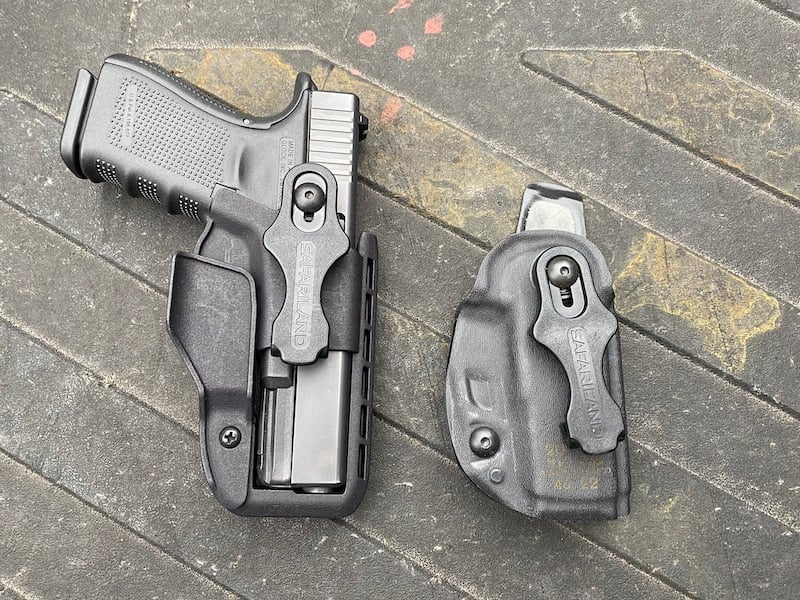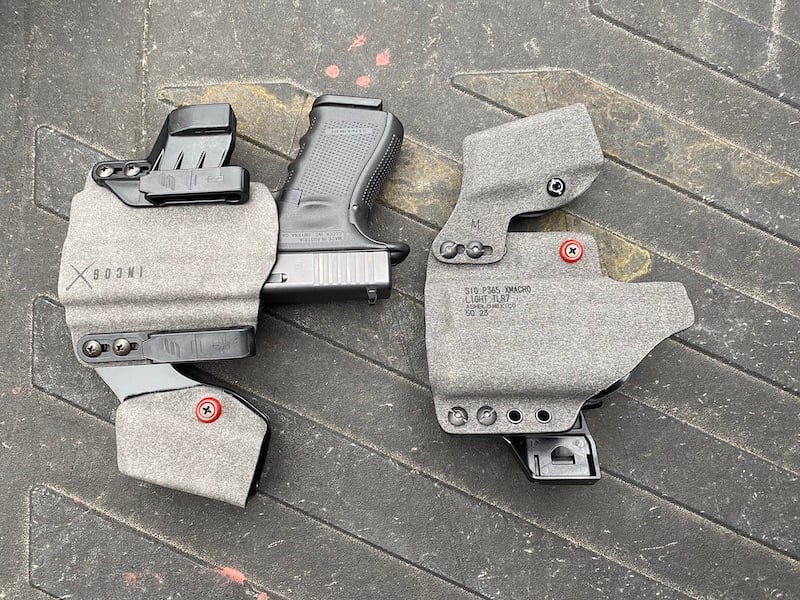Safariland’s outside-the-waistband (OWB) holsters are in a class of their own. While competitors still chase the brand in the law enforcement and military markets, there’s no comparison. But when it comes to IWB holsters and concealed carry, Safariland has historically struggled.
The explanation here is easy enough to understand. Safariland, as a larger corporate entity, began with holsters but expanded in many directions, including armor, forensics, and other LE-centric lines. Over 60 years, they bought John Bianchi’s leather line (now Bianchi holsters) and Bill Roger’s innovative thermoformed holster business (Roger’s Holsters, which they incorporated into Safariland).
Almost all of what Safariland calls “Concealment” holsters are holsters that originated as Duty Holsters. Take off the UBL and slap on a paddle, and presto: Concealment. Yet they’re not easily concealed, and they aren’t IWB.
There are a few notable models that have a dedicated following.
The Safariland Model 17
For years, Safariland relied on the Model 17 for IWB. The Model 17 is an effective and rather simple design. The thermoformed material—Boltaron—is quite thin. It is so thin, in fact, that it has a good bit of flex to it.
It will hold a gun secure, though. When a gun is in the Model 17, it provides the stiffness it needs to hold effectively. Once you draw, though, it may collapse down on itself under the tension of the belt.

The clip on this is metal, which many prefer over the polymer clips. It is certainly thin. The whole design is sewn together. The profile of the build won’t accommodate red dots or lights, but neither of those were in common usage when the Model 17 was designed.
The Safariland Model 27
The Model 27 takes the formality of the Safariland line to the next level. This is a dressy IWB design built with a thermoformed interior covered with black leather. The clip comes over the pants and behind the belt, with a slight J-hook to catch the belt on the draw.
When compared to the 17, the Model 27 is more rigid. The layered build of the holster, though, means added girth that you’ll need to conceal.
The Safariland Model 18
The Model 18 is similar, except the outside of the holster has a grey leather covering. The clip on the Model 18 has two loops that go over the belt. While the 18 is easy enough to get on and off, the loops print a bit more than the Model 17’s steel clip. The Model 18 is very comfortable to wear and the leather allows it to hold well against bare skin.

The Safariland 575
Here’s a bit of retail insight. Gun stores love mutli-fit holsters. The counter-staff can point at a holster aisle and say “and if you want an IWB holster for this [insert gun make/model here], look for the Safariland 575.”
One holster that fits a wide variety of guns is easy to stock and easy to order, and the 575 fits just a lot of guns.
It also incorporates the GLS (Grip Locking System). This attaches to the trigger guard.

Here, though, is the rub. While the 575 is cut for optics, the GLS system sits where a light would be inside the holster. So there’s no light compatibility.
And customers, though, don’t always want an active security mechanism on an IWB holster. This goes back to the thumb-safety debate on EDC guns. Any extra obstacle, be it the GLS lock or a manual safety, can stand in the way of an effective defensive use of a firearm.
Customers, Safariland found out, also like dedicated fits. While the 575 proved more popular than some of the other holsters in the IWB family, they are still an acquired taste.
Safariland Schema
The Schema is a wild departure for Safariland. The injection molded design is quite skeletal. This pulls out excess material that could print. The bulk in this holster is on the sides, and those sides are rounded–making them very comfortable to wear.
The Schema has a trigger guard detent. Like the 575, this holster isn’t light-compatible, but it is cut for optics. The clip can be turned to adjust the cant.
Schema is an incredibly easy holster to wear. It is quite compact and thin, provides a solid hold on the gun, and there are no obstacles between you and a solid shooting grip during the draw.

Species
Safariland launched Species and Schema in the same design cycle. There’s a reason for that. Both of these holsters provide dedicated fits that cover the top end of the best-selling gun lists. They’re designs that allow new fits to be added frequently–especially Species. But why double up?
Schema is odd. When it launched, the reaction was polarized. There were those who loved it and those who hated it, but few people in the middle. Species, as a thermoformed design, is far more traditional.
Species, too, appeals to those looking for a simple EDC holster. There are no light-bearing options, yet. There’s not an accompanying mag caddy.
Haley Strategic and the Incog X
Schema and Species opened minds about Safariland’s IWB line. The Incog X, though, is doing exceptionally well with those who are more determined with their concealed carry training. Incog X is an appendix carry holster that will accommodate lights, optics, and a spare mag.

The fuzzed exterior grips inside the pants and helps hold the holster steady–something harder to do on slick Kydex designs. The clip has adjustable shims that help push the holster deeper into the waist. It is an efficient design that is comfortable and highly effective.
Incog X is an odd build for Safariland but not for Travis Haley and Haley Strategic Partners. Haley’s team studies ergonomics and use cases and trains compulsively to work out their design concepts. One goal for this brand collaboration was to get HSP’s design into wider distribution–to make effective EDC available to anyone.
A change in the IWB tide?
From an end-user perspective, both Schema and Species drew attention. Both perform exceptionally well. Incog X, though, marks the first IWB holster Safariland has produced that those of us who are very discerning about concealed carry and active training have taken seriously.
The holster hasn’t been out a year, now, and they’ve added fits for the GLOCKS, Sigs, Staccatos, and more are coming. As of now, the intention is to drop a new fit every 4-6 weeks. While most are built for the small lights, like the TLR-7, more options are on the way.
And now, for the first time for Safariland, there’s a backward flow to the old business model. Rather than making a holster for LE and then hoping the rest of us might take an interest, Safariland has built for EDC, and LE agencies are picking up the designs for use with backup guns (Schema and Species) and for undercover units (Incog X).


